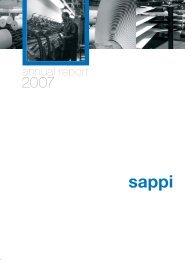2012 Integrated report - Sappi
2012 Integrated report - Sappi
2012 Integrated report - Sappi
You also want an ePaper? Increase the reach of your titles
YUMPU automatically turns print PDFs into web optimized ePapers that Google loves.
Chief financial officer’s <strong>report</strong> continued<br />
Section 5<br />
Balance sheet<br />
Summarised balance sheet<br />
US$ million <strong>2012</strong> 2011<br />
Property, plant and equipment 3,157 3,235<br />
Plantations 555 580<br />
Net working capital 511 409<br />
Other assets 278 273<br />
4,501 4,497<br />
Net post-employment liabilities (510) (450)<br />
Other liabilities (487) (469)<br />
Employment of capital 3,504 3,578<br />
Equity 1,525 1,478<br />
Net debt 1,979 2,100<br />
Capital employed 3,504 3,578<br />
Property, plant and equipment<br />
The cost, depreciation and impairments related to our property,<br />
plant and equipment are set out in the table below.<br />
We have 17 mills in seven countries capable of producing<br />
approximately four million tons of pulp and six million tons of paper<br />
products. For more information on our mills, their production<br />
capacities and products, please refer to pages 36 and 41.<br />
Book value of property, plant and equipment<br />
<strong>2012</strong> 2011<br />
Cost 9,375 9,531<br />
Accumulated depreciation and impairments 6,218 6,296<br />
Net book value 3,157 3,235<br />
During <strong>2012</strong>, capital expenditure for property, plant and<br />
equipment was US$404 million, including US$190 million for the<br />
dissolving pulp projects. We depreciated fixed assets by a further<br />
US$367 million. In addition, we processed net asset impairments<br />
of US$10 million, principally related to the curtailing of certain<br />
production lines in South Africa.<br />
Currency translation differences reduced the net book value<br />
by US$86 million compared with 2011.<br />
The capacity replacement value of the property, plant and<br />
equipment for insurance purposes has been assessed at<br />
approximately US$23 billion.<br />
Plantations<br />
We regard ownership of our plantations in Southern Africa as<br />
a key strategic resource which gives us access to low cost fibre<br />
to feed our pulp production. We currently have access to<br />
approximately 400,000 hectares of plantable land of which<br />
approximately 378,000 hectares are planted with pine and<br />
eucalyptus. Our plantations provide approximately 70% of<br />
the wood requirements for our Southern Africa mills.<br />
The reduction in the carrying value of plantations in fiscal <strong>2012</strong><br />
was mainly due to the weaker South African Rand versus the<br />
US Dollar at year end when translating our <strong>report</strong>ing currency.<br />
In terms of the relevant accounting standard, we value these<br />
plantations on our balance sheet at fair value less the estimated<br />
cost of delivery, including harvesting and transport costs.<br />
In notes 2.3.5 and 10 to the financial statements considerable<br />
detail is provided about our accounting policies for plantations.<br />
Working capital<br />
The component parts of our working capital at the <strong>2012</strong> and<br />
2011 financial year ends are shown in the table below:<br />
Net working capital<br />
<strong>2012</strong> 2011<br />
Inventories 726 750<br />
Trade and other receivables 807 831<br />
Trade and other payables (1,022) (1,172)<br />
Net working capital 511 409<br />
Optimising working capital remains a key focus area for us and is<br />
incorporated into the management incentive schemes for all<br />
businesses. We benchmark our working capital ratios against<br />
those of industry peers.<br />
The working capital investment is seasonal and typically peaks<br />
during quarter 3 of the financial year. Net working capital<br />
increased by US$102 million during fiscal <strong>2012</strong>. The material<br />
reasons for the change are the following:<br />
> Inventories decreased by US$24 million reflecting lower sales<br />
volumes across all three regions;<br />
> Receivables continue to be tightly managed and reduced by<br />
US$24 million. This was achieved despite a sundry debtor of<br />
US$42 million for the sale of the Jiangxi Joint Venture. The<br />
quality of credit management is demonstrated by a bad debt<br />
charge of US$11 million for <strong>2012</strong>, only 0.2% of sales; and<br />
> Payables decreased by US$150 million, largely as a result<br />
of the utilisation of restructuring provisions that existed at<br />
September 2011 for the closure of the Biberist Mill and<br />
the rationalisation of regional management structures.<br />
Post-employment liabilities<br />
We operate various defined benefit, post-retirement, medical aid<br />
and other types of funds in the various countries in which<br />
we operate. A summary of defined benefit assets and liabilities<br />
is as follows:<br />
60
















